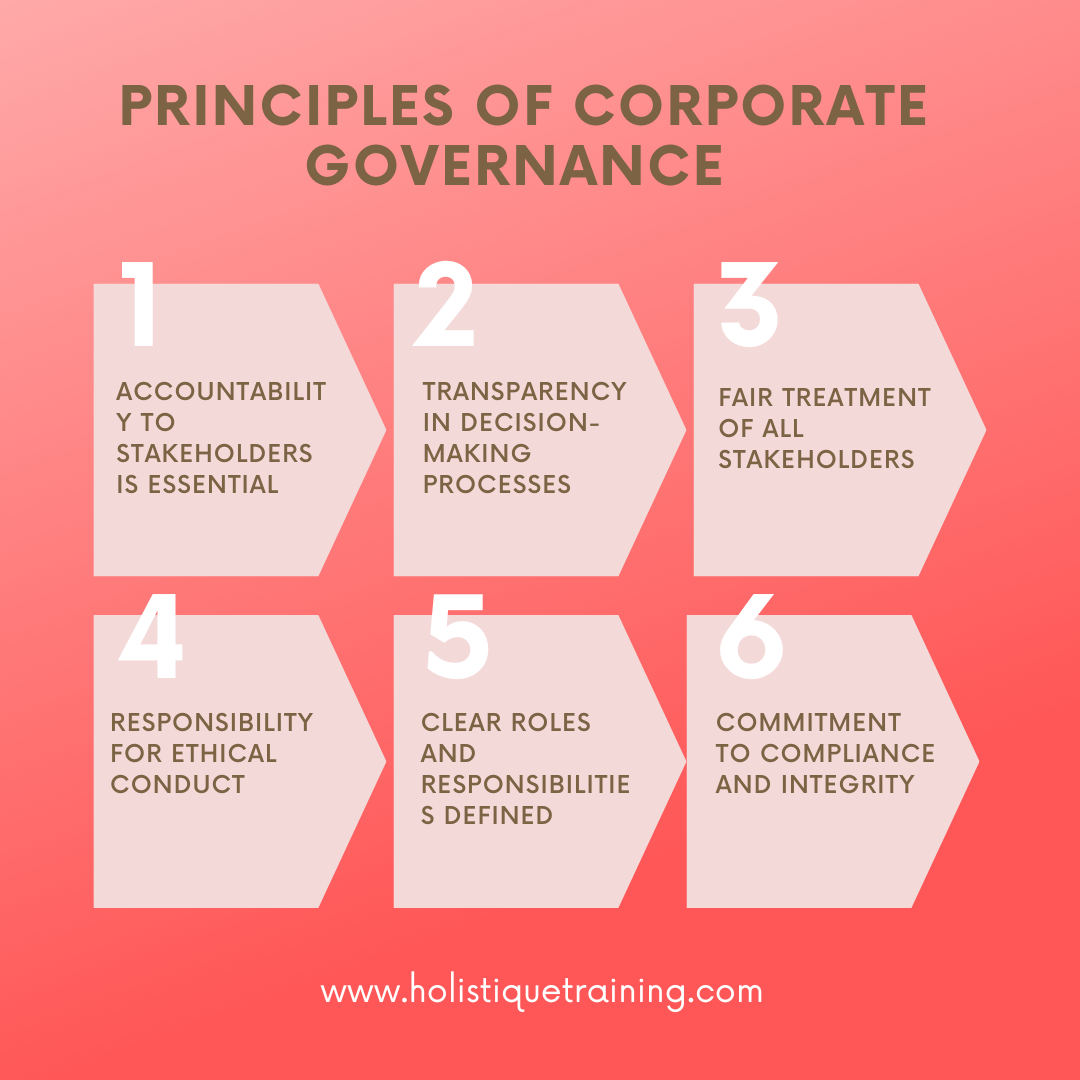- Table of Contents
- Introduction
- What is Corporate Governance?
- The Principles of Corporate Governance
- Accountability:
- Transparency:
- Fairness:
- Responsibility:
- Stakeholder Engagement:
- Independence:
- Why is Corporate Governance Important?
- Enhances Organizational Performance:
- Builds Trust and Reputation:
- Reduces Risk:
- Attracts Investment:
- Ensures Compliance:
- Promotes Sustainability:
- Facilitates Long-Term Success:
- Corporate Governance and Compliance
- Foundation for Compliance:
- Risk Management:
- Alignment with Organizational Goals:
- Stakeholder Trust and Reputation:
- Regulatory Scrutiny and Accountability:
- Continuous Improvement:
- Benefits of Corporate Governance Training
- Enhanced Understanding of Governance Principles:
- Improved Decision-Making:
- Strengthened Accountability and Oversight:
- Increased Compliance Awareness:
- Promotion of Ethical Culture:
- Better Risk Management:
- Enhanced Stakeholder Engagement:
- Attraction and Retention of Talent:
- Adaptation to Changing Environments:
- Steps to Get Started with Corporate Governance Training
- 1- Assess Training Needs:
- 2- Define Training Objectives:
- 3- Select Training Format and Content:
- 4- Identify Trainers and Resources:
- 5- Develop a Training Schedule:
- 6- Implement the Training Program:
- 7- Evaluate Training Effectiveness:
- 8- Continuous Improvement:
- 9- Foster a Culture of Governance:
- Conclusion
Introduction
Corporate governance is a critical aspect of the modern business landscape, influencing how companies operate and how they are perceived by stakeholders. This blog post delves into the multifaceted concept of corporate governance, exploring its definition, principles, importance, and the role it plays in compliance and training. By the end of this discussion, readers will gain a comprehensive understanding of corporate governance and its vital role in fostering ethical business practices and sustainable growth.
What is Corporate Governance?
Corporate governance refers to the systems, principles, and processes by which a company is directed and controlled. It encompasses the mechanisms through which organizations, particularly publicly traded companies, are operated and regulated. The concept extends beyond mere compliance with laws and regulations; it involves the relationships among various stakeholders, including shareholders, management, the board of directors, employees, customers, and the broader community.
At its core, corporate governance aims to ensure that companies are accountable and transparent in their operations. It establishes a framework for achieving a company’s objectives while balancing the interests of all stakeholders. Effective corporate governance promotes ethical decision-making, enhances organizational performance, and fosters a culture of integrity.
The Principles of Corporate Governance
The principles of corporate governance serve as the foundation for effective governance practices. While these principles may vary across different jurisdictions and organizations, several key tenets are universally recognized:
Accountability:
Corporate governance structures should ensure that all members of the organization are accountable for their actions. This principle emphasizes the importance of clear roles and responsibilities within the organization. Accountability mechanisms, such as performance evaluations and regular reporting, help ensure that individuals are held responsible for their decisions, fostering a culture of ownership and integrity. When accountability is ingrained in the organizational culture, it encourages proactive problem-solving and ethical behavior.
Transparency:
Organizations must provide timely and accurate information regarding their financial performance and governance practices. Transparency fosters trust among stakeholders and enhances the credibility of the organization. By openly sharing relevant information, companies can mitigate misunderstandings and build strong relationships with investors and customers. Furthermore, transparency not only helps in compliance with regulatory requirements but also empowers stakeholders to make informed decisions regarding their engagement with the company.
Fairness:
All stakeholders, including minority shareholders, should be treated equitably. Fairness ensures that no group is unjustly favored over another, promoting a sense of justice within the organization. This principle calls for the establishment of policies and practices that protect the rights of all stakeholders, particularly those who may have less influence. By promoting fairness, organizations can enhance their reputation and foster loyalty among stakeholders, which can lead to long-term success and stability.
Responsibility:
Companies should be responsible for their actions and decisions, particularly regarding their impact on the environment and society. This principle encourages organizations to act ethically and consider the broader implications of their activities. By adopting sustainable practices and corporate social responsibility initiatives, companies can demonstrate their commitment to societal welfare. This responsibility extends to ensuring that business practices do not harm the environment and contribute positively to the communities in which they operate.
Stakeholder Engagement:
Effective corporate governance involves engaging with stakeholders to understand their concerns and expectations. This engagement helps organizations align their strategies with stakeholder interests. By fostering open communication channels, companies can gain valuable insights into stakeholder perspectives, leading to more informed decision-making. Engaging stakeholders not only enhances trust but also allows organizations to anticipate and address potential issues before they escalate.

Independence:
An independent board of directors is essential for effective governance. Independence ensures that decisions are made objectively and without undue influence from management or other parties. An independent board can provide unbiased oversight and bring diverse perspectives to the decision-making process. This independence is crucial for maintaining checks and balances within the organization, ensuring that the interests of all stakeholders are considered in strategic planning and operational execution.
These principles form the bedrock of effective corporate governance, guiding organizations in their efforts to achieve sustainable success. By adhering to these principles, companies can build a solid foundation for ethical conduct and long-term growth.
Why is Corporate Governance Important?
The significance of corporate governance cannot be overstated. It plays a crucial role in shaping the behavior of organizations and influencing their long-term viability. Here are several reasons why corporate governance is essential:
Enhances Organizational Performance:
Companies with strong governance practices tend to perform better financially. Effective governance fosters a culture of accountability and strategic decision-making, leading to improved operational efficiency and profitability. When governance structures are well-defined, they facilitate better resource allocation, clearer objectives, and more effective risk management. As a result, organizations can respond more adeptly to market changes and capitalize on emerging opportunities, ultimately driving growth.
Builds Trust and Reputation:
Transparent and ethical governance practices enhance a company’s reputation among stakeholders. Trust is a valuable asset in business, and organizations that prioritize corporate governance are more likely to earn the confidence of investors, customers, and the public. A strong reputation can lead to increased customer loyalty, better employee engagement, and a more favorable perception in the marketplace. Moreover, companies known for their ethical practices often find it easier to attract top talent and maintain positive relationships with regulators and community stakeholders.
Reduces Risk:
Strong corporate governance frameworks help identify and mitigate risks. By establishing clear processes for decision-making and accountability, organizations can avoid potential pitfalls and navigate challenges more effectively. This proactive approach to risk management not only protects the organization from financial losses but also safeguards its reputation. Furthermore, effective governance practices can help organizations respond to crises more swiftly and effectively, minimizing the impact of unforeseen events.
Attracts Investment:
Investors are more likely to invest in companies with robust governance structures. Strong governance signals to investors that the organization is well-managed and committed to ethical practices, making it a more attractive investment opportunity. Investors often conduct thorough due diligence before committing funds, and a solid governance framework can be a decisive factor in their investment decisions. Additionally, companies with strong governance are often seen as lower risk, which can lead to lower capital costs and improved access to financing.
Ensures Compliance:
Corporate governance is closely tied to regulatory compliance. Organizations that adhere to governance principles are better equipped to comply with legal and regulatory requirements, reducing the risk of legal issues and penalties. A well-structured governance framework helps ensure that compliance is integrated into the company’s operations, fostering a culture of ethical behavior and accountability. This alignment not only protects the organization from potential legal repercussions but also enhances its reputation as a responsible corporate citizen.
Promotes Sustainability:
In today’s business environment, sustainability is a key concern for stakeholders.Corporate governance encourages organizations to consider their social and environmental impact, promoting sustainable practices that benefit both the company and society. By integrating sustainability into their governance frameworks, companies can address stakeholder expectations and contribute to broader societal goals. This commitment to sustainability can also lead to innovation, as organizations explore new ways to reduce their environmental footprint and enhance their social contributions.
Facilitates Long-Term Success:
Ultimately, effective corporate governance is essential for the long-term success of any organization. By prioritizing governance, companies can create a solid foundation for sustainable growth, resilience, and adaptability in an ever-changing business landscape. Strong governance practices enable organizations to navigate challenges, seize opportunities, and align their strategies with stakeholder interests, ensuring that they remain competitive and relevant in the marketplace.
In summary, corporate governance is not merely a regulatory requirement; it is a strategic imperative that influences every aspect of an organization’s operations. By understanding and prioritizing the importance of corporate governance, companies can position themselves for success in a complex and dynamic environment.
Corporate Governance and Compliance
Corporate governance and compliance are interrelated concepts that play a vital role in ensuring organizational integrity. While compliance refers to the adherence to laws, regulations, and internal policies, corporategovernance encompasses the broader framework of accountability and ethical behavior. Understanding the relationship between these two elements is crucial for organizations aiming to achieve sustainable success and maintain stakeholder trust.
Foundation for Compliance:
Effective corporate governance provides the foundation for compliance efforts within an organization. A well-structured governance framework establishes clear roles, responsibilities, and processes that are essential for ensuring compliance with legal and regulatory requirements. Governance structures, such as boards of directors and audit committees, play a critical role in overseeing compliance activities and ensuring that the organization adheres to relevant laws and standards. By embedding compliance into the governance framework, organizations can create a culture of accountability and ethical conduct.
Risk Management:
Corporate governance frameworks often include mechanisms for identifying and managingcompliance risks. Organizations that prioritize governance are better equipped to recognize potential compliance issues before they escalate into significant problems. This proactive approach to risk management enables companies to implement effective controls and monitoring systems that mitigate the likelihood of non-compliance. By integrating compliance into their governance strategies, organizations can safeguard against legal penalties, reputational damage, and financial losses.
Alignment with Organizational Goals:
Compliance should not be viewed as a standalone function but rather as an integral part of the organization’s overall strategy. Strong corporate governance ensures that compliance efforts are aligned with the organization’s goals and objectives. This alignment helps organizations prioritize compliance initiatives that support their strategic vision while also addressing stakeholder concerns. By fostering a culture where compliance is seen as a shared responsibility across all levels of the organization, companies can enhance their overall performance and reputation.
Stakeholder Trust and Reputation:
The relationship between corporate governance and compliance significantly impacts an organization’s reputation and stakeholder trust. Companies that demonstrate a commitment to ethical governance practices and compliance are more likely to gain the confidence of investors, customers, and the public. Conversely, organizations that experience compliance failures often face severe reputational damage, which can lead to a loss of business and investor confidence. By cultivating a strong governance framework that prioritizes compliance, organizations can enhance their credibility and foster long-term relationships with stakeholders.
Regulatory Scrutiny and Accountability:
In an era of increasing regulatory scrutiny, organizations must be vigilant in their compliance efforts. Strong corporate governance frameworks facilitate accountability by ensuring that individuals responsible for compliance are held accountable for their actions. This accountability extends to board members, executives, and employees, creating a culture where compliance is taken seriously at all levels. By establishing clear reporting lines and oversight mechanisms, organizations can ensure that compliance issues are addressed promptly and effectively.
Continuous Improvement:
Corporate governance encourages organizations to adopt a mindset of continuous improvement in their compliance efforts. Regular assessments of governance structures and compliance programs can help identify areas for enhancement and ensure that the organization remains responsive to evolving legal and regulatory requirements. By fostering a culture of learning and adaptation, organizations can stay ahead of compliance challenges and maintain a robustgovernance framework that supports their long-term success.
In conclusion, the interplay between corporate governance and compliance is essential for fostering a culture of integrity and accountability within organizations. By prioritizing effective governance practices, companies can create a solid foundation for compliance that enhances their reputation, mitigates risks, and supports sustainable growth. Embracing this relationship not only protects the organization from potential legal repercussions but also positions it as a responsible corporate citizen committed to ethical practices and stakeholder engagement.
Benefits of Corporate Governance Training
Corporate governance training is an essential investment for organizations aiming to enhance their governance practices and foster a culture of accountability and ethical behavior. The benefits of such training extend beyond mere compliance; they contribute to the overall effectiveness and sustainability of the organization. Here are some key advantages of corporate governance training:
Enhanced Understanding of Governance Principles:
Corporate governance training provides participants with a comprehensive understanding of governance frameworks, principles, and best practices. This knowledge equips board members, executives, and employees with the tools they need to navigate the complexities of governance effectively. By fostering a deeper appreciation of governance roles and responsibilities, training helps ensure that all stakeholders are aligned in their commitment to ethical conduct and accountability.
Improved Decision-Making:
Training in corporate governance enhances decision-making processes within the organization. Participants learn to evaluate risks, assess opportunities, and consider the implications of their decisions on various stakeholders. This improved decision-making capability leads to more informed and strategic choices that align with the organization’s goals. Ultimately, better decision-making contributes to enhanced organizational performance and sustainability.
Strengthened Accountability and Oversight:
Effective corporate governance training emphasizes the importance of accountability and oversight mechanisms. Participants gain insights into their roles in monitoring and evaluating organizational performance, ensuring compliance, and addressing potential conflicts of interest. By reinforcing the principles of accountability, training fosters a culture where individuals take ownership of their responsibilities, leading to more effective governance practices.
Increased Compliance Awareness:
Corporate governance training helps raise awareness of legal and regulatory requirements among employees and board members. Understanding compliance obligations is crucial for mitigating risks associated with non-compliance. Training programs often cover relevant laws, regulations, and industry standards, equipping participants with the knowledge needed to navigate compliance challenges. This heightened awareness contributes to a culture of compliance and ethical behavior within the organization.
Promotion of Ethical Culture:
Training in corporate governance fosters an ethical organizational culture by emphasizing the importance of integrity and ethical decision-making. Participants learn about the significance of ethical behavior in governance and the potential consequences of unethical practices. By promoting an ethical culture, organizations can reduce the likelihood of misconduct, enhance employee morale, and build trust with stakeholders.
Better Risk Management:
Effective governance training equips participants with the skills to identify, assess, and manage risks effectively. Understanding risk management principles enables organizations to implement proactive strategies to mitigate potential threats. By fostering a risk-aware culture, organizations can enhance their resilience and adaptability in the face of challenges, ensuring long-term sustainability.
Enhanced Stakeholder Engagement:
Corporate governance training emphasizes the importance of stakeholder engagement and communication. Participants learn how to effectively interact with various stakeholders, including investors, employees, customers, and regulators. Improved stakeholder engagement leads to better relationships, increased trust, and a more inclusive decision-making process. Organizations that prioritize stakeholder engagement are better positioned to understand and address the needs and concerns of their constituents.
Attraction and Retention of Talent:
Organizations that invest in corporate governance training demonstrate a commitment to professional development and ethical practices. This commitment can enhance the organization’s reputation and attractiveness to potential employees. A strong governance culture can also contribute to higher employee satisfaction and retention rates, as individuals are more likely to stay with organizations that prioritize ethical behavior and transparency.
Adaptation to Changing Environments:
The business landscape is constantly evolving, with new regulations, technologies, and societal expectations emerging regularly. Corporate governance training helps organizations stay current with these changes by providing insights into best practices and emerging trends. By fostering a culture of continuous learning, organizations can adapt more effectively to changing environments and maintain their competitive edge.
In summary, corporate governance training offers numerous benefits that contribute to the overall effectiveness and integrity of organizations. By investing in training programs, companies can enhance their governance practices, promote ethical behavior, and position themselves for long-term success in an increasingly complex business landscape.
Steps to Get Started with Corporate Governance Training
Implementing corporate governance training is a strategic initiative that can significantly enhance an organization’s governance practices and overall effectiveness. Here are the key steps to get started with corporate governance training:
1- Assess Training Needs:
- Begin by conducting a thorough assessment to identify the specific governance training needs of your organization. Consider factors such as the current level of governance knowledge among board members, executives, and employees, as well as the existing governance framework and practices.
- Engage stakeholders through surveys or interviews to gather insights on their perceptions of governance challenges and areas for improvement. This assessment will help tailor the training program to address the unique needs and gaps within the organization.
2- Define Training Objectives:
- Clearly outline the objectives of the corporate governance training program. Objectives should align with the organization’s strategic goals and address the identified training needs. For instance, objectives may include enhancing understanding of governance principles, improving decision-making skills, and fostering a culture of accountability.
- Setting specific, measurable, achievable, relevant, and time-bound (SMART) objectives will provide a clear framework for evaluating the success of the training program.
3- Select Training Format and Content:
- Choose the most appropriate training format based on the organization’s needs and resources. Options may include in-person workshops, online courses, webinars, or blended learning approaches that combine various formats.
- Develop or select training content that is relevant, engaging, and practical. Content should cover key governance topics such as roles and responsibilities, compliance requirements, risk management, and ethical decision-making. Incorporating case studies, real-world examples, and interactive activities can enhance participant engagement and learning.
Here are some example activities that could be done:
Activity | Description |
Case Study Analysis | Participants analyze real-world governance failures and successes |
Role-Playing Scenarios | Simulate governance dilemmas to practice decision-making skills |
Group Discussions | Facilitate discussions on governance principles and ethical challenges |
Compliance Workshops | Engage participants in understanding legal and regulatory requirements |
Action Plan Development | Teams create action plans for improving governance practices |
4- Identify Trainers and Resources:
- Select qualified trainers or facilitators who have expertise in corporate governance and can effectively deliver the training program. Consider individuals with experience in governance, legal compliance, or organizational development. External consultants or industry experts can also provide valuable insights and perspectives.
- Gather necessary resources, such as training materials, handouts, and access to online platforms or learning management systems, to support the training program.
5- Develop a Training Schedule:
- Create a training schedule that accommodates the availability of participants while ensuring sufficient time for comprehensive coverage of the topics. Consider factors such as the frequency and duration of training sessions, as well as any potential conflicts with organizational activities.
- Communicate the training schedule to all participants well in advance to encourage attendance and engagement.
6- Implement the Training Program:
- Launch the corporate governance training program according to the established schedule. Ensure that all participants are aware of the training objectives, format, and expectations.
- Foster an open and inclusive learning environment where participants feel comfortable sharing their thoughts, asking questions, and engaging in discussions. Encourage active participation through group activities, role-playing scenarios, and case study analyses.
7- Evaluate Training Effectiveness:
- After the training sessions, gather feedback from participants to evaluate the effectiveness of the program. Use surveys, interviews, or focus groups to assess participants’ perceptions of the training content, delivery, and relevance to their roles.
- Measure the achievement of training objectives by assessing participants’ knowledge and skills before and after the training. This evaluation will help identify areas of success as well as opportunities for improvement.
Table: Metrics to measure the effectiveness of corporate governance training
Metric | Description |
Participant Feedback | Collect surveys to gauge satisfaction and relevance of training |
Knowledge Retention | Assess understanding through pre- and post-training tests |
Behavioral Change | Evaluate changes in decision-making and governance practices |
Compliance Rates | Monitor adherence to governance policies and regulations |
Stakeholder Engagement | Measure improvements in communication and trust with stakeholders |
8- Continuous Improvement:
- Based on the feedback and evaluation results, make necessary adjustments to the training program to enhance its effectiveness. Continuous improvement ensures that the training remains relevant and aligned with the organization’s evolving governance needs.
- Consider establishing ongoing governance training initiatives, such as refresher courses or advanced training sessions, to reinforce learning and keep participants updated on emerging governance trends and best practices.
9- Foster a Culture of Governance:
- Beyond formal training, encourage a culture of governance within the organization. Promote discussions about governance practices in meetings, share relevant articles or resources, and recognize individuals who exemplify strong governance behaviors.
- Leadership commitment to corporate governance and continuous learning will help embed governance principles into the organizational culture, ensuring long-term sustainability and effectiveness.
By following these steps, organizations can effectively implement corporate governance training that enhances their governance practices, fosters ethical behavior, and positions them for long-term success. Investing in governance training not only strengthens the organization’s internal structures but also builds trust and confidence among stakeholders.
Conclusion
Corporate governance is a fundamental aspect of modern business that influences organizational success and sustainability. By understanding the principles of corporate governance, its importance, and the relationship between governance and compliance, organizations can foster a culture of accountability and ethical behavior. Investing in corporate governance training equips employees and board members with the knowledge and skills necessary to navigate the complexities of governance effectively.
Embracing corporate governance not only enhances organizational performance but also builds trust with stakeholders, reduces risks, and promotes sustainable practices. As businesses continue to evolve in a dynamic environment, prioritizing corporate governance will be essential for long-term success and resilience. By taking proactive steps to implement effective governance practices and training programs, organizations can position themselves for a brighter future, benefiting not only their bottom line but also the communities they serve.

























